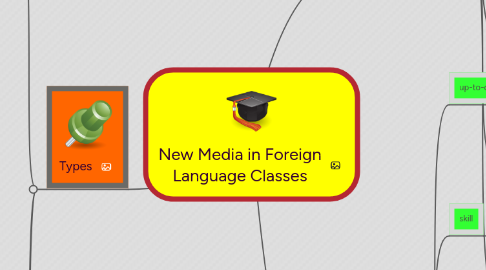
1. Types
1.1. Computer
1.1.1. Internet
1.1.1.1. Online Tools
1.1.1.1.1. Wordclouds
1.1.1.1.2. Bookmarking
1.1.1.1.3. Collaborative Writing
1.1.1.1.4. Comic Creation
1.1.1.1.5. Podcasts
1.1.1.1.6. Learning Software
1.1.1.1.7. For Teachers
1.1.1.1.8. Other
1.1.2. Learning Software
1.1.2.1. Vocabulary
1.1.2.2. Grammar
1.1.2.3. Recording Software
1.1.3. What it contains
1.1.3.1. TV
1.1.3.2. MP3-Player
1.1.3.3. Tablet-PC
1.1.3.4. Smartboard
1.2. Smartboard
1.2.1. Document Camera
1.2.2. Interactive Response System
1.2.3. Wireless Slate
1.2.4. Smart Table
1.2.5. Data Projector
1.2.5.1. Films
1.2.5.2. Pictures
1.2.5.3. Maps
1.2.5.4. Presentaion
1.3. Microphone + Camera
1.3.1. Creative Recording
1.3.1.1. Interview
1.3.1.2. Dialogue
1.3.1.3. Story
1.3.1.4. Discussion
1.3.2. Control Ponounciation
2. Deficiencies
2.1. Technical Know-How
2.1.1. Teacher
2.1.1.1. Training
2.1.1.1.1. Students better than Teacher
2.1.1.2. Older vs. Younger
2.1.2. Students
2.1.2.1. danger of disadvantage
2.2. Cost
2.2.1. theft
2.2.2. purchase
2.2.3. vandalism
2.2.4. running expenses
2.3. Time-consuming
2.3.1. Preparation
2.3.2. accelerating of device
2.4. Danger of not-working
2.4.1. alway plan b
2.4.2. data loss
2.4.2.1. during work (crash)
2.4.2.2. general (damage of hardware)
2.5. Health
2.5.1. Computer
2.5.1.1. posture
2.5.1.2. eyes
2.5.1.3. danger of addiction
2.6. digital life instead of real life
2.6.1. digital learning instead of real learning (dissecting frog on whiteboard-screen instead of dissecting it for real in the lab)
2.6.2. loosing ties to nature
2.6.3. no real communication skills (no problem mailing someone but problem talking to someone)
2.7. content
2.7.1. ephemerality of information on the internet
2.7.2. appropriateness of information on the internet
2.7.2.1. youth protection
2.7.3. data protection
3. Chances
3.1. up-to-dateness
3.1.1. of information
3.1.2. digital learning material
3.1.2.1. interactive
3.1.2.2. easy dublication (sharing)
3.1.2.3. updates (when mistakes are found)
3.2. skill
3.2.1. future
3.2.1.1. job
3.2.1.2. studies
3.2.2. general media competence
3.3. creativity
3.3.1. see tools
3.3.2. artistically untalented pupils can produce something beautiful
3.3.3. varying methods
3.4. audio
3.4.1. listening
3.4.1.1. to native speakers
3.4.1.2. to themselves
3.4.2. real communication
3.4.2.1. e-mail
3.4.2.1.1. penpal
3.4.2.2. facebook
3.4.2.3. video messages
3.4.2.4. chat
3.4.2.4.1. video chat
3.5. diminishment
3.5.1. of weight (500 books on one tablet)
3.5.2. of paperflow
3.5.2.1. environmental protection
3.5.3. of volume (one pc instead of 3 bis shelves)
